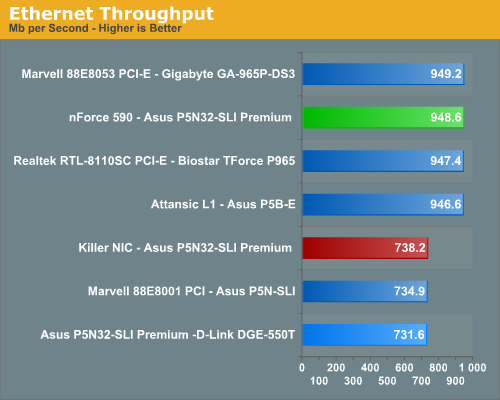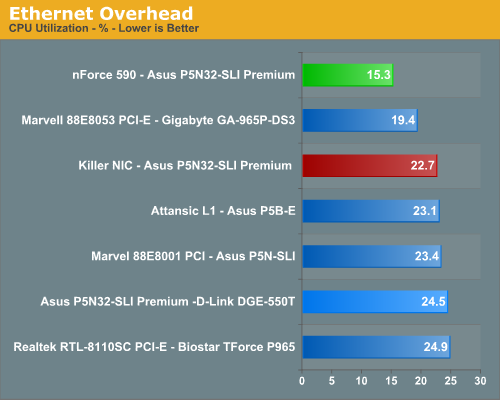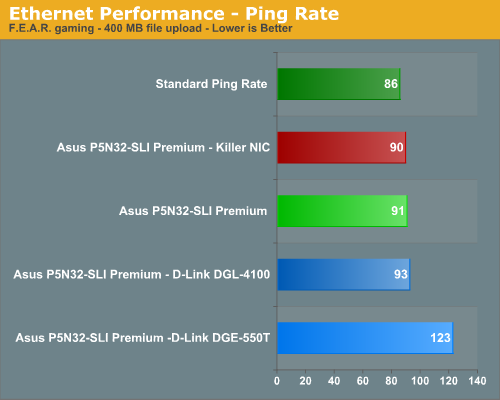BigFoot Networks Killer NIC: Killer Marketing or Killer Product?
by Gary Key on October 31, 2006 2:00 AM EST- Posted in
- Networking
Ethernet NIC Performance
Our current motherboard test suite includes LAN performance measurements and we will utilize this same test today. All of the boards listed utilize PCI or PCI Express based controllers with the only difference being the supplier of the core logic.
The Windows 2000 Driver Development Kit (DDK) includes a useful LAN testing utility called NTttcp. We used the NTttcp tool to test Ethernet throughput and the CPU utilization of the various Ethernet Controllers used on the Intel motherboards.
We set up one machine as the server; in this test, an Intel system with an Intel CSA Gigabit LAN connection. Intel CSA has a reputation for providing fast throughput and is a logical choice for our Gigabit LAN server.
On the server side, we used the following Command Line as suggested by the VIA whitepaper on LAN testing:


No real surprises here as the Killer NIC has a Marvell PHY and utilizes the PCI interface for operation. The throughput rates and CPU utilization of the Killer NIC was very competitive with our other PCI based solutions. However, the NVIDIA nForce 590SLI had the best overall performance numbers in these tests. BigFoot Networks was adamant about the fact they concentrated on lower latency and not improving throughput on the card since most network connections while gaming will not saturate the PCI bus.
Ethernet Outbound Ping Performance
Our final benchmark takes a look at the ping performance of each of our products while playing F.E.A.R. and uploading a 400 MB file to a separate client on another network. Our D-Link DGL-4100 router and the NVIDIA nForce 590SLI include packet prioritization for outbound traffic while gaming. We decided to see how well these solutions stacked up with the Killer NIC that can also prioritize inbound traffic.

All three of our products that advertise packet prioritization are within 3% of each other in the numbers with our D-Link DGE-550T trailing by around 33%. Why a serious gamer would actually want to upload large files while playing online is beyond us but in case you want to then our three solutions provide the capability to do so without an issue. However, be aware that throughput suffered by an average of 44% for the upload file test with our three solutions when compared to the D-Link NIC during testing.
Our current motherboard test suite includes LAN performance measurements and we will utilize this same test today. All of the boards listed utilize PCI or PCI Express based controllers with the only difference being the supplier of the core logic.
The Windows 2000 Driver Development Kit (DDK) includes a useful LAN testing utility called NTttcp. We used the NTttcp tool to test Ethernet throughput and the CPU utilization of the various Ethernet Controllers used on the Intel motherboards.
We set up one machine as the server; in this test, an Intel system with an Intel CSA Gigabit LAN connection. Intel CSA has a reputation for providing fast throughput and is a logical choice for our Gigabit LAN server.
On the server side, we used the following Command Line as suggested by the VIA whitepaper on LAN testing:
Ntttcpr -m 4,0,‹server IP› -a 4 -l 256000 -n 30000
On the client side (the motherboard under test), we used the following Command Line:Ntttcps -m 4,0,‹client IP› -a 4 -l 256000 -n 30000
At the conclusion of the test, we captured the throughput and CPU utilization figures from the client screen.

No real surprises here as the Killer NIC has a Marvell PHY and utilizes the PCI interface for operation. The throughput rates and CPU utilization of the Killer NIC was very competitive with our other PCI based solutions. However, the NVIDIA nForce 590SLI had the best overall performance numbers in these tests. BigFoot Networks was adamant about the fact they concentrated on lower latency and not improving throughput on the card since most network connections while gaming will not saturate the PCI bus.
Ethernet Outbound Ping Performance
Our final benchmark takes a look at the ping performance of each of our products while playing F.E.A.R. and uploading a 400 MB file to a separate client on another network. Our D-Link DGL-4100 router and the NVIDIA nForce 590SLI include packet prioritization for outbound traffic while gaming. We decided to see how well these solutions stacked up with the Killer NIC that can also prioritize inbound traffic.

All three of our products that advertise packet prioritization are within 3% of each other in the numbers with our D-Link DGE-550T trailing by around 33%. Why a serious gamer would actually want to upload large files while playing online is beyond us but in case you want to then our three solutions provide the capability to do so without an issue. However, be aware that throughput suffered by an average of 44% for the upload file test with our three solutions when compared to the D-Link NIC during testing.










87 Comments
View All Comments
Gary Key - Wednesday, November 1, 2006 - link
We tested these two cards as part of our Killer NIC testing routine. We did not report the numbers as they did not vary greatly from the NIVIDA 590SLI NIC solution.Crassus - Wednesday, November 1, 2006 - link
Sorry, but that plus the server test would have been very useful information I would have liked in the review. Or maybe we can have a different review, sort of a "NIC roundup". If your results are the same across the board, it's a finding worth mentioning as well, isn't it?Frumious1 - Tuesday, October 31, 2006 - link
I bet it doesn't even beat the onboard NVIDIA NIC. Or rather, it will tie the NVIDIA solution, which means it's equal to the Killer in most situations and fractionally slower in a few games. Maybe it has lower CPU usage when doing gigabit transmits, but high bandwidth with low CPU usage isn't going to matter much for gaming. Not that any NIC related stuff matters much for gaming these days.vaystrem - Tuesday, October 31, 2006 - link
I agree its very difficult to test NIC performance and kudos to Anandtech for trying. But, it seems to me that using the card as a server for the games where it saw the most improvement, Fear/CS, and even for those that it didn't may be more enlightening than exploring the client side of things.Gary Key - Tuesday, October 31, 2006 - link
We set up one of our test beds as a server for a couple of the games we tested. The performance was actually worse than our NVIDIA NIC (dualnet/teaming), Intel PRO/1000 PT, and barely did better than our D-Link PCI NIC in half of the tests. We will not fault the card for its peformance since it was specifically designed as a client side card. This very well could change in the future due to their ability to optimize driver code on the FPGA unit. The article could have gone another five pages with the server and LAN tests that we completed (neither showed any significant differences). It appears from several of the comments that anything over three pages was a waste anyway. ;-)EODetroit - Tuesday, October 31, 2006 - link
Except according to the PR material the card is made for game clients, not optimized for game servers.VooDooAddict - Tuesday, October 31, 2006 - link
While the POSIBILITY of embeded linux apps is interesting. For someone who would have the $$ do buy this ... they would have the money to put inexpensive PC parts together into a linux machine. Likely they have spare parts leftover from thier last upgrade.Anyone else think the company name is strangly fitting? "BigFoot" ... Myth and Hype?
Certainly not saying a nice NIC isnt'a good investment ... but at almost $300 ... it's a joke. Drop the embedded linux, hit the $50 price point and this thing would probably sell like mad to WoW Addicts. (eventually also have a PCIe version)
The aegia(sp?) physics processor is the same way. Great concept, but the tangable benefits are so minimal for the price. $300 Video cards took off because there was a tangable benefit.
Dropping anothre $300 into the Storage System, Monitor, CPU, Video card, RAM, or even Audio system (surround speakers) would give one a much mroe imersive experience.
Someone made the wrong decission to stick with the embedded linux thing. Seriously a sperate leftover parts Linux box and a DLINK 4100 router would be a far better way to go.
So any guesses as to the next $300 (*caugh* gimic *caugh*) expendature to "improve" gaming?
For those comparing this to SLI/Crossfire. SLI and Crossfire can offer substantial image quality enhancements for people with large pixel count LCDs. The ability to run LCDs at native resolution for gaming is a very tangable benefit. Not something everyone agrees it worth the $$. But the benefit is there.
VooDooAddict - Tuesday, October 31, 2006 - link
I was really hoping for somethign major from this card ... just from the perspective of reliving history.Around 10 years ago now (back around '96-'97) when NICs weren't build onboard spending $60-$70 on a 3Com 3c905 or a server class Intel NIC would make a bug differance in overall system performace when working with the Internet, LAN, and Gaming. They gave me big advantages over anyone who just went out an bought a cheapo $20 NE2000 comptable NIC (16-bit ISA even!).
I'm talking Quake 1, Duke3D, Quake 2, Quake CTF, Original Unreal... A single 3dFx VooDooGraphics Board + 3c905 = pwnage (back when "pwnage" was still a typo). I was so often accused of cheating by laptop wielding, software emulating, newbies (wasn't spelt "noob" then).
... That above is why I picked up the handle "VooDooAddict"
EODetroit - Tuesday, October 31, 2006 - link
And they deleted it. Claiming it needed to be moved from "Testimonials" to "General" forum. Whatever, but they didn't actually move my post, they deleted it and replaced it with a post of their own, with the link, plus quoted all the good things said in the Anandtech review and none of the bad. Typical and misleading, but hey, its their web site. They can do what they want. Still, misleading people doesn't endear them to anyone.LoneWolf15 - Tuesday, October 31, 2006 - link
I admire the amount of engineering that went into this product. It's obvious that the product isn't "snake oil" in the same way that, say, SoftRAM software was back in the day. There's a lot more to this card than just a NIC.That said, I don't think it provides enough benefit to justify $279 (unless perhaps you're making $50k+ a year in the PGL). Today's NICs are already pretty well optimized for most situations, plus many mainboard NICS are directly on the PCIe bus, something the Killer NIC can't offer (and as someone pointed out, try doing gig ethernet across a PCI slot; it really isn't feasible, especially if you already have the PCI bus shared with other components like a TV tuner or sound card). The Killer NIC's most interesting feature, FNApps, is not useful at the moment, and I'm still concerned that it might pose a security risk through a malformed application (that's assuming someone coded that app in the first place, considering how little marketshare the Killer NIC is likely to have). Like the Ageia PhysX, at this point in time, I don't see the justification.
P.S. Is it just me, or does the heatsink "K" look like a Klingon weapon? I'm thinking either Klingon brass-knuckles or a hybrid bat-lef. ;)